SHM -4
Here 
Generalising the result :
Hence 
Combining of SHM’s :
The resultant motion of a particle, if 2 forces which produce SHM are applied over it, is a combination of the two SHM’s.
The two SHM’s are then combined using the theory of vectors.
If SHM I : 
SHM II :
then 
where 
And then 
Derivation :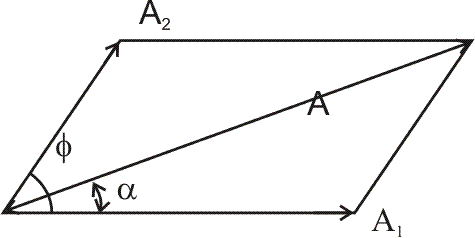
The two SHM’s have a phase diffrences  . So this can be treated as the difference in ‘angle’ between the two SHM with magnitude rule.
. So this can be treated as the difference in ‘angle’ between the two SHM with magnitude rule. .
.
So by parellelagram rule, = Resultant vector such that
= Resultant vector such that
# Illustration : Find the displacement equation of SHM by combining 

Solution : Let the resultant equation be :
then,
Resultant 


 .
.
Ans. Question :- The Potential energy of a particle ascillating on x axis is  where
where  are constant.
are constant.
The total mechanical energy of particle is  joules.
joules.
Here  is also in joules while x is metres.
is also in joules while x is metres.
Is the motion SHM ? Where is its mean particle?
Solution :- 

Changing  {shifting of coordinate axis}
{shifting of coordinate axis}
Force  so motion is a SHM.
so motion is a SHM.
At Mean position Potential energy = minimum and Force = 0
So 
 Mean position. Ans.
Mean position. Ans.
Question - 2. Two particle move parellel to x axis about origin with same amplitude and frequency. At a certain instant, they both are found at a distance A/n from origin (y>1) and they are on opposite sides of the origin. Their velocities are found to be in same direction. Find the phase diference between two ?
Solution :- The problem becomes very simple if we represent both SHM’s on a circle.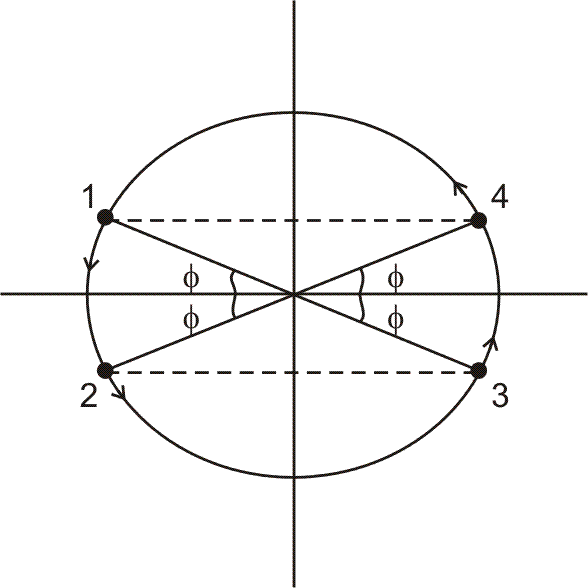
The particle positions are 1/2/3/4
But as they are an opposite sides, and their velocity in same directin so either 1 and 2 or 3 and 4. The phase difference will be  where
where 
 Ans.
Ans.
Question - 3. A particle executes SHM with w = 3.4 and amplitude 2m. Find (a) time period (b) Maximum speed (c) Maximum accelaration (d) Speed where displacement is .5m from mean position.
Solution :- Let SHM be 
(a) Time period = 
(b) Max Speed = v = 2w = 6.28 m/s.
(c) Max Accelaration = 
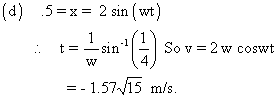 Ans.
Ans.
Question - 4. The pulley of mass =  as shown has a moment of Inert =
as shown has a moment of Inert =  . The spring has a spring constant
. The spring has a spring constant  . Find the time period of ascillation of its centre of mass ? [string slip over pulley]
. Find the time period of ascillation of its centre of mass ? [string slip over pulley]
Solution :-
At equilibrium : 
Now let initial extension in spring = 

Now we appoach the problem using Energy method :
Suppose centre of mass of pulley goes down by ‘x’. the spring extends further by ‘2x’. Energy of system.
Now  So
So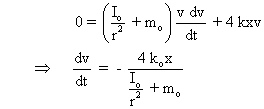

Question - 5. A simple pendulum is susoended from the acting of a car which is moving down the inclined plane with constant velocity. The inclmation angle is  Find time period of pendulum ?
Find time period of pendulum ?
Solution :-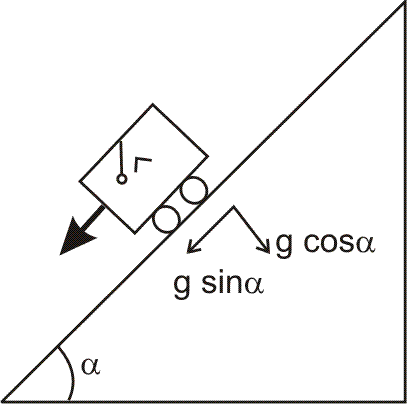
For the pendulum bob;
The  in a direction perpendicular to inclined plane ! So we just have to replace the
in a direction perpendicular to inclined plane ! So we just have to replace the  instead of
instead of  in formula for time period o a simple pendulum.
in formula for time period o a simple pendulum.
Question - 6. A regid body is suspended from a fixed support O. Find the time period of its ascillations if its moment of initia is ‘I’ distance between O and of mass is ’d’ and mass is  ?
?
Solution :-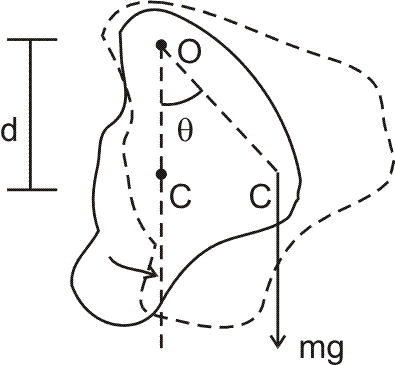
Suppose the body is displaced by small angle  . Now torque on body about O is
. Now torque on body about O is

- This result can be remembered as such.